Dr Gary Baker, Postgraduate Research Fellow on the Medieval Warhorse Project, has been systematically working through the accounts of royal warhorses in medieval England. Here he presents some of the findings of that work
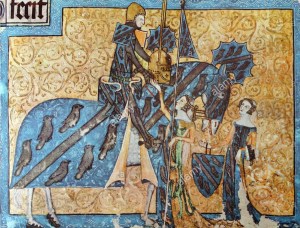
Sir Geoffrey Lutterell, assisted by his wife and daughter-in-law
The warhorses of England’s medieval monarchs were some of their most prized possessions. Not only did they have a practical use in war and the tournament, but they also served to represent the king’s wealth and power to his people, with coursers, and especially the elite destriers, acting as physical embodiments of this power. They were important as gifts to those whom the king wished to reward for good and loyal service, and those wishing to curry favour with the king often presented him with prized destriers. Warhorses, therefore, acted as an important social glue which bound the king to his people.
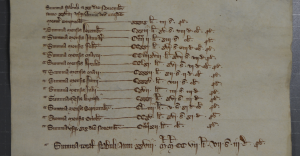
(Fig. 1) Detail of an account showing the monthly expenses of stabling Edward I’s horses in 1299-1300
The maintenance, care, and upkeep of the royal warhorses has generated a huge number of records, many of which can be found in The National Archives UK. The amount of money spent on these animals shows just how important they were. From November 1298 to the end of his reign in July 1307, for example, Edward I spent nearly £16,000 on stabling his horses alone; nearly £1,800 a year (fig. 1). Edward and his successors continued to spend large amounts of money on the upkeep of royal horses. They were also keen on improving the quality of their warhorses, acquiring new animals from both home and abroad. In 1334-35, for instance, Arnold Garcy, keeper of the king’s great horses south of the Trent, travelled to Spain to purchase great horses for Edward III, including the purchase of 23 such animals for a total of £715 13s 4d.
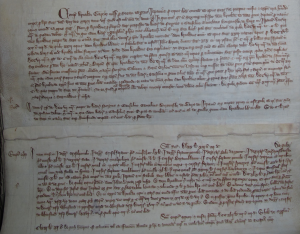
Account of Arnold Garcy, keeper of the king’s horses south of the Trent, going to buy horses in Spain in 1334-35.
Edward III’s reign provides particularly rich information on the maintenance of the royal warhorses. From the start of his reign the king appointed separate keepers of the ‘great horses’ (a catch-all term applied mainly to destriers and coursers, but which sometimes incorporated other types of horse), north and south of the Trent. The accounts of these keepers provide minute details relating to their receipts and expenses including fodder (oats, cut grass, hay, bran, horse bread) equine equipment (bridles, lunges, reins, saddles, stirrups, trammels, hobbles, horseshoes, and halters), the wages of grooms and farriers, medicines purchased to treat ailments (including vinegar, honey, powdered ginger, tallow, ointments, and bandages), and candles for lighting the lamps around the stables and helping the grooms to see in the dark winter months.
The destriers in particular were well-fed on a diet of oats and hay, with each animal consuming up to half a bushel a day (with a bushel weighing roughly 40lbs) which would have made them more likely and liable to bite and kick. Unfortunately the records do not record the size of these elite animals in horse hands (hh), though the destriers’ diet would suggest they were large by contemporary if not modern standards, perhaps 15hh. Indeed, stature and musculature were likely more important qualities for warhorses to possess to the medieval mind than height, which explains why the latter information is never recorded in medieval English accounts. It has been estimated, given the volume of oats they consumed, that destriers probably weighed 1,600lbs or more. Compared to present-day thoroughbreds which weigh roughly 1,000lbs, the medieval destrier was doubtlessly an impressive animal.
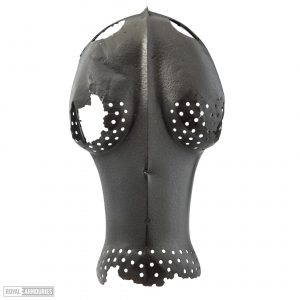
The famous Warwick shaffron, housed in The Royal Armouries
Every care was afforded these horses, as disease could ravage a herd. ‘Murrain’ (a catch-all term which was applied in the accounts to a variety of equine ailments) was a particular problem. At the stud at Ightenhill in Lancashire in 1331-32, twenty-one out of the twenty-three newborns that year succumbed to the disease. Other diseases could be just as contagious. In October 1326 one grey at Reading died of farcy, a serious bacterial disease which causes growths in the lymph vessels. Wooden and thatch buildings where the horses were stabled were also at risk of fire. Three of the king’s ‘great horses’ (2 destriers and 1 courser) being kept in stables at Wellingborough, Northamptonshire, died in a fire that started in the night of 14 April 1352 outside of the stables, though the clerk was quick to assert that their keeper, William de Fremelesworth, was not at fault.
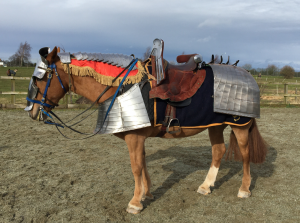
Copper, a mare at the Leeds Royal Armouries in her full armour. Mares like Copper were not used as warhorses in medieval England. Instead they were utilised as riding horses and baggage animals on campaign.
The adult stallions – all destriers and coursers in medieval England were male – were accounted for and, presumably, stabled separately from the mares, colts, and foals, which were kept at the king’s studs which were located all over the country. Some of the major studs in the north were at Ightenhill, Knaresborough, Burstwick, and Plumpton; whilst in the south, Cornbury, Guildford, Rayleigh, Princes Risborough, Stratfield Mortimer, Woodstock, and Windsor predominated. From at least Edward III’s reign these studs do not appear to have had resident stallions, with the great horses being sent to cover the mares at different studs in rotation.
The accounts also provide information on the number of the horses present within these studs, with detailed records kept of the numbers throughout the year, as can be seen from this example for Stratfield Mortimer, Berkshire, in 1349-50. Detailed descriptions were also provided of the coat colours of the animals to aid identification.
| Type | Start | End | Total Acc. for | Males at End | Females at End |
| Mares | 17 | 16 | 17 | 0 | 16 |
| Colts | 4 | 0 | 4 | 0 | 0 |
| Fillies | 7 | 4 | 7 | 0 | 4 |
| Newborns | 0 | 6 | 6 | 3 | 3 |
| Total | 28 | 26 | 34 | 3 | 23 |
Mares: start 17 (1 bay with white spots and two rear white feet, 1 bay, 1 white-grey with one left rear foot, 1 black which blends into grey, 3 greys, 1 brown bay with two rear white feet, 2 blacks with stars in front, 3 sorrels with white spots, 1 black with two white front feet, 1 grey with white spots, 1 brown bay, and 1 bay-grey); 1 brown bay mare died on 4 October 1349, as appears in the inquiry headed by Adam de Dene, ordered by the king to inquire into the deaths of the king’s horses in the memoranda delivered to the treasurer enrolled in the Hillary term of the 25th year of Edward III (1351–52) (16). Colts: start 4 born the previous year; 3 were delivered to Odiham on 4 October 1349 for breaking in amongst the king’s great horses (1); the remaining colt died on 3 October 1349. Fillies: start 7 (1 of 2.5yrs old, 1 of 1.5yrs old, and 5 born the previous year); 1 black filly, then 3yrs old, died on 5 June 1350, and on 11 June 1 grey then 1yr old died, and 1 black filly, then 1yr old, died on 16 June (4). Newborns: 6 born this year (3 colts and 3 fillies), all of which remain at the end of the account.
When young horses reached maturity (usually around 3.5yrs old for fillies and 2.5yrs old for colts) the colts were sent for training and breaking in amongst the king’s great horses, and some of the mares were selected for breeding. The remainder were either sold or sent to the household to act as horses for messengers, as riding horses, or as gifts to members of the household.
Warhorse numbers in the royal studs and stables obviously varied over time, ranging from 500-600 horses of all types over the period 1320-60. From c. 1360, however, the large numbers of horses were sold and the new position of Master of the Horse was created. The man occupying this position became an important official in the royal household, but instead of dealing with hundreds of animals, he was tasked with maintaining a smaller number of more elite beasts.